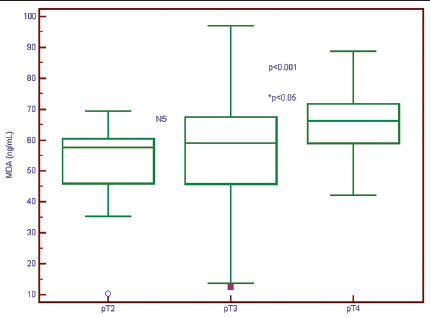Evaluation of serum levels of malondialdehyde and endogenous non-enzymatic antioxidants in relation to colorectal cancer stage and intestinal wall infiltration
DOI:
https://doi.org/10.17532/jhsci.2021.1387Keywords:
Colon cancer, malondialdehyde, non-enzymatic antioxidantsAbstract
Introduction: Oxidative stress and lipid peroxidation are pointed as possible factors in the development of colorectal cancer (CRC). The aim of this study was to assess the serum malondialdehyde (MDA) and non-enzymatic antioxidants concentration (albumin, bilirubin, uric acid, and ferritin) and their relation with the stage and histopathologic size (pT) of CRC.
Methods: One hundred and twenty patients with clinically and histopathologically confirmed CRC and the need for surgical treatment were included in a cross-sectional study. All patients were divided into groups according to the disease stage and depth of tumor invasion. The control group included 30 subjects with no signs of malignant and inflammatory bowel disease. The patients and controls did not receive vitamin supplementation. Peripheral venous blood was sampled before the surgical treatment of CRC patients and on the day of the examination of control subjects for determination of serum MDA and the concentration of the non-enzymatic antioxidants.
Results: The serum levels of MDA were progressively increased in CRC patients with the highest level in the fourth stage of disease and pT4 group. Ferritin levels increased significantly with the CRC stage and decreased with the depth of bowel wall invasion. Serum albumin concentration significantly decreased with increasing stage and increasing depth of tumor invasion of the intestinal wall, while serum bilirubin level showed no change compared to the control group. Serum uric acid concentration was significantly higher in CRC patients, but no difference was observed with CRC progression. It was confirmed that serum albumin significantly negatively correlated with the CRC stage (rho = −0.649, p < 0.001), while serum MDA significantly positively correlated with the CRC stage (rho = 0.750, p < 0.001).
Conclusion: These results indicate that serum MDA concentrations are related to the progression of CRC, to which the imbalance in non-enzymatic antioxidants also contributes.
Downloads

Downloads
Published
License
Copyright (c) 2021 Ismar Rašić, Sandin Holjan, Vedad Papović, Sanjin Glavaš, Adi Mulabdić, Azra Rašić

This work is licensed under a Creative Commons Attribution 4.0 International License.










